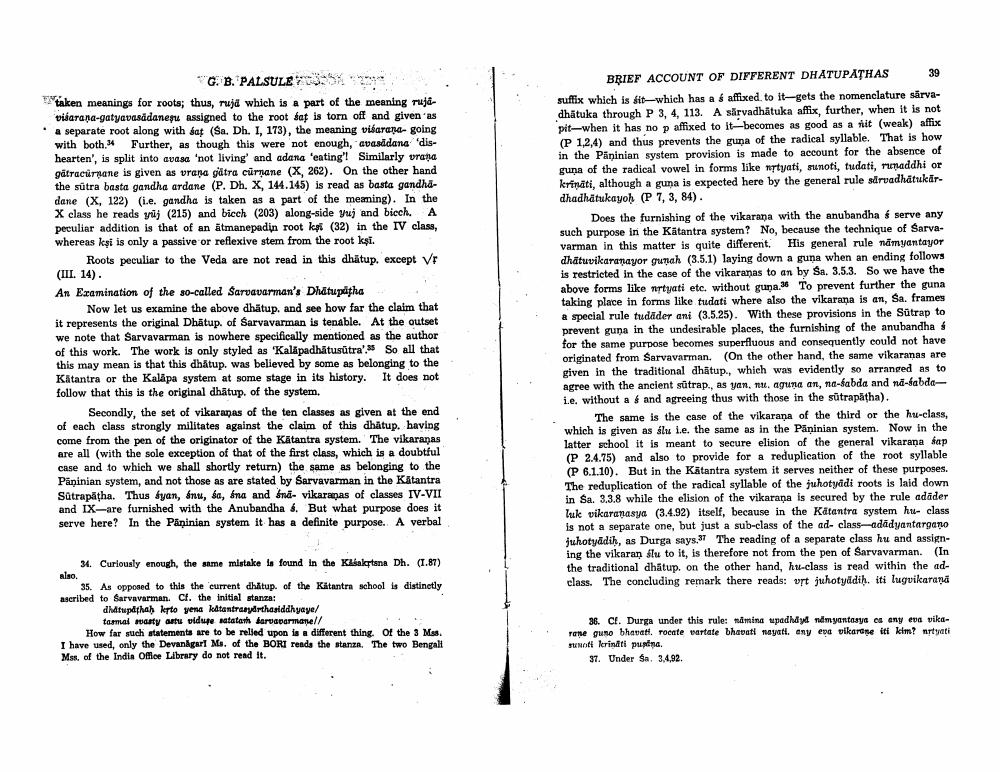Book Title: Brief Account Of Different Dhatupatras Author(s): G B Palsule Publisher: G B Palsule View full book textPage 2
________________ "G. B. PALSULES: taken meanings for roots; thus, rujd which is a part of the meaning mujavisarana-gatyavasddanene assigned to the root sag is torn off and given as a separate root along with saf (Sa. Dh. 1, 173), the meaning vidare going with both. Further, as though this were not enough, Gvaddana 'dishearten', is split into avasa 'not living and adana 'eating'! Similarly vrana gitracinane is given as vrana gatra cürnane (X, 262). On the other hand the sutra basta gandha ardane (P. Dh. X, 144.145) is read as basta gandhddane (X, 122) (i.e. gandha is taken as a part of the meaning). In the X class he reads vij (215) and bicch (203) along-side wuj and biech. A peculiar addition is that of an atmanepadin root kpl (32) in the IV class, whereas kşi is only a passive or reflexive stem from the root kl. Roots peculiar to the Veda are not read in this dhātup, except Ve (III. 14). An Examination of the so-called Sarvavarman's Dhatupdtha Now let us examine the above dhatup, and see how far the claim that it represents the original Dhātup. of Sarvavarman is tenable. At the outset we note that Sarvavarman is nowhere specifically mentioned as the author of this work. The work is only styled as "Kalapadhatusūtra's So all that this may mean is that this dhåtup. was believed by some as belonging to the Katantra or the Kalapa system at some stage in its history. It does not follow that this is the original dhătup. of the system, Secondly, the set of vikaranas of the ten classes as given at the end of each class strongly militates against the claim of this dhatup. having come from the pen of the originator of the Kätantra system. The vikaranas are all (with the sole exception of that of the first class, which is a doubtful case and to which we shall shortly return) the same as belonging to the Papinian system, and not those as are stated by Sarvavarman in the Katantra Satrapitha. Thus byen, énu, ko, ina and S. vikarapas of classes IV-VII and IX-are furnished with the Anubandha & But what purpose does it serve here? In the Paninian system it has a definite purpose. A verbal BRIEF ACCOUNT OF DIFFERENT DHATUPATHAS 39 suffix which is fit-which has a $ affixed to it-gets the nomenclature sirvadhātuka through P 3, 4, 113. A sarvadhituka affix, further, when it is not pit-when it has no p affixed to it-becomes as good as a nit (weak) affix (P 1,2,4) and thus prevents the guna of the radical syllable. That is how in the Papinian system provision is made to account for the absence of or the radical vowel in forms like artyati, minoti, tudati, rumaddhi or krinati, although a guna is expected here by the general rule sirvadhatukardhadhatukayoh (P 7, 3, 84). Does the furnishing of the vikarana with the anubandha s serve any such purpose in the Kätantra syster? No, because the technique of Sarvavarman in this matter is quite different. His general rule nämyantayor dhātuvikaranayor gunah (3.5.1) laying down a guna when an ending follows is restricted in the case of the vikaranas to an by Sa. 3.5.3. So we have the above forms like nrtyati etc. without guna. To prevent further the guna taking place in forms like tudati where also the vikarana is an, Sa. frames a special rule tudader ani (3.5.25). With these provisions in the Satrap to prevent guna in the undesirable places, the furnishing of the anubandha 6 for the same purpose becomes superfluous and consequently could not have originated from Sarvavarman. (On the other hand, the same vikaranas are given in the traditional dhatup., which was evidently so arranged as to agree with the ancient sutrap, as yan, na, aguna an, na-fabda and nd-fabdai.e. without a & and agreeing thus with those in the sutrapatha). The same is the case of the vikarana of the third or the hw-class, which is given as slu i.e. the same as in the Påninian system. Now in the latter school it is meant to secure elision of the general vikarana fap (P 2.4.75) and also to provide for a reduplication of the root syllable (P 6.1.10). But in the Kitantra system it serves neither of these purposes. The reduplication of the radical syllable of the fuhotyadi roots is laid down in Sa. 3.3.8 while the elision of the vikarana is secured by the rule adader luk vikaranasya (3.4.92) itself, because in the Kitantra system hue class is not a separate one, but just a sub-class of the ad-class-adadyantargano juhotyadih, as Durga says. The reading of a separate class hu and assigning the vilaran su to it, is therefore not from the pen of Sarvavarman (In the traditional dhatup, on the other hand, hu-class is read within the adclass. The concluding remark there reads: ust juhotyldih. iti lugvikarard 34. Curiously enough, the same mistake found in the Klaktana Dh. (1.87) also 35. As opposed to this the current dhatup of the Kitantra school is distinctly ascribed to Sarvavarman. Cf. the initial stanza: dhatupdhah kpto yena katantranyarthasiddhyaye/ tammal wasty au viduse natatath karvaparmanel/ How far such statements are to be relied upon to a different thing of the 3 Mss. I have used, only the Devangart Mo. of the BORI reada the stanza. The two Bengali Mss of the India Office Library do not read it. s 36. Cl. Durga under this rule: mina wpadhyl ndyantasya es any eva vikaTone gune bhavati roonte vartate bhavati mayat any epa vikaruse ti kim? niyati i kerinti pusina 37. Under Ss. 3.4.92.Page Navigation
1 2 3 4 5 6 7 8 9
